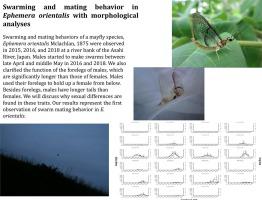Journal of Asia-Pacific Entomology ( IF 1.1 ) Pub Date : 2021-02-01 , DOI: 10.1016/j.aspen.2021.01.012 Takahisa Miyatake , Taichi Suge , Shunsuke Suzaki , Shintaro Tanabe , Ryo Ishihara , Kentarou Matsumura

|
Swarming and mating behaviors of a mayfly species, Ephemera orientalis Mclachlan, 1875 were observed in 2015, 2016, and 2018 at a river bank of the Asahi River, Japan. Males started to make swarms between late April and middle May in 2016 and 2018. The numbers of mated pairs in a swarm correlated with the numbers of flying males in a swarm in 2016 and 2018. Swarms were formed during a limited period at dusk most probably because that interval is free from natural enemies. Males competed with each other to copulate with females in swarms. We clarified the function of the forelegs of males, which are significantly longer than those of females. Males used their forelegs to hold up a female from below. Besides forelegs, males have longer tails than females. We will discuss why sexual differences are found in these traits. Our results represent the first observation of swarm mating behavior in E. orientalis.
中文翻译:

1875年东方EpMclachlan的群居和交配行为(表翅目:Ephemeridae),并进行了形态学分析
may(Ephhemera Orientalis) may类的成群和交配行为在2015年,2016年和2018年在日本旭河的河岸观察到了麦克拉克兰(Mclachlan),1875年。在2016年和2018年4月下旬至5月中旬之间,雄性开始成群。2016年和2018年,成群的交配对数与成群飞行的雄性数相关。最有可能在黄昏的有限时期内形成群体。因为该间隔没有天敌。雄性相互竞争,成群结队地与雌性交配。我们阐明了雄性前肢的功能,其明显长于雌性。雄性用其前肢从下面举起雌性。除前肢外,雄性的尾巴比雌性更长。我们将讨论为什么在这些特征中发现性别差异。我们的结果代表了群体交配行为的首次观察E.侧柏。









































 京公网安备 11010802027423号
京公网安备 11010802027423号